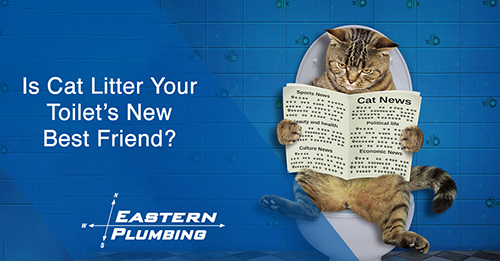It’s the age-old question, should you flush your cat litter down the toilet?
In short, no. But why?
For starters, flushing kitty litter down the toilet can cause damage to your septic tank. Your septic tank is designed to break down human waste and biodegradable tissue. Cat litter throws off your septic tank’s balance and disrupts the process of breaking down human waste.
However, this isn’t the only reason you should avoid flushing your cat litter. Cat litter is usually made out of bentonite clay, a substance that, when wet, hardens into a consistency almost like cement. The clay can easily clump and get stuck in your pipes when you flush your litter. Clay getting clogged in your drain pipes might not happen the first time you flush kitty litter down the toilet, but the build-up can lead to serious issues over time. Not only is this a difficult problem to fix, but it’s an expensive one. Harden, clumped together bentonite clay can require removal and replacement of your plumbing hardware, which can be costly.
So what should you do to properly dispose of cat litter?
As recommended, you should scoop all urine and feces tainted kitty litter into a bag and tightly tie it together before throwing it away. Any kitty litter remaining should be double-bagged and tightly sealed to avoid any leakage and thrown away. This may seem more complicated and time-consuming than simply flushing your litter down the toilet, but it will save your bank account in the long run.
Another option for disposing of cat litter would be using a cat litter that is compostable and made from natural ingredients like wheat, pine, walnut shells, and corn. When disposing of compostable kitty litter, keep it away from water sources, gardens, or anything you plan on eating for dinner. And remember – just because it’s compostable doesn’t mean you can flush it.
If cat litter has clogging your pipes or you have any other plumbing issue, call Eastern Plumbing at 252-758-7579.






